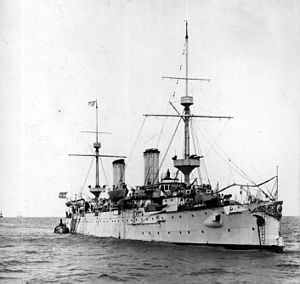
Yashima was a Fuji-class pre-dreadnought battleship built for the Imperial Japanese Navy (IJN) in the 1890s. As Japan lacked the industrial capacity to construct such vessels, the ship was designed and built in the United Kingdom. She participated in the early stages of the Russo-Japanese War of 1904–1905, including the Battle of Port Arthur on the second day of the war. Yashima was involved in subsequent operations until she struck two mines off Port Arthur in May 1904. The ship did not sink immediately, but capsized while under tow later that day. The Japanese were able to keep her loss a secret from the Russians for over a year. As a result, the Russians were unable to take advantage of the ship's loss.

HMS Collingwood was the lead ship of her class of ironclad battleships built for the Royal Navy during the 1880s. The ship's essential design became the standard for most of the following British battleships. Completed in 1887, she spent the next two years in reserve before she was assigned to the Mediterranean Fleet for the next eight years. After returning home in 1897, the ship spent the next six years as a guardship in Ireland. Collingwood was not significantly damaged during an accidental collision in 1899 and was paid off four years later. The ship was sold for scrap in 1909 and subsequently broken up.
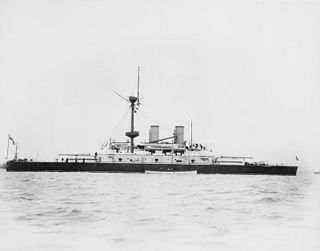
HMS Howe was an Admiral-class ironclad battleship built for the Royal Navy during the 1880s. The ship was assigned to the Channel Fleet in mid-1890 and was badly damaged when she ran aground in late 1892. After repairs were completed, Howe was transferred to the Mediterranean Fleet in late 1893. She returned home in late 1896 and became a guardship in Ireland. Howe remained there until late 1901 when she was assigned to the Reserve Fleet. The ship was paid off in three years later and then sold for scrap in 1910.

HMS Anson was the last of six Admiral-class ironclad battleships built for the Royal Navy during the 1880s. The ship was completed, except for her armament, in 1887, but had to wait two years for her guns to be installed. She was assigned to the Channel Fleet in mid-1889 as a flagship for the fleet's second-in-command. Two years later, the passenger ship SS Utopia sank with the loss of 562 lives after colliding with Anson in the Bay of Gibraltar. In mid-1893, Anson was transferred to the Mediterranean Fleet, subsequently returning home in 1900 when she was assigned to the Reserve Fleet. She recommissioned for the Home Fleet in early 1901. Anson was paid off three years later and then sold for scrap in 1909.

HMS Sparrowhawk was a B-class torpedo boat destroyer of the Royal Navy. She was completed by Laird, Son & Company, Birkenhead, and was launched on 8 October 1895. She served on the China Station and was wrecked in the mouth of the Yangtze River in 1904. She was one of four Quail-class destroyers.

The Eclipse-class cruisers were a class of nine second-class protected cruisers constructed for the Royal Navy in the mid-1890s.
HMS Haughty was a Hardy-class destroyer which served with the Royal Navy. She was launched by William Doxford & Sons on 18 September 1895, served in home waters, and was sold on 10 April 1912.
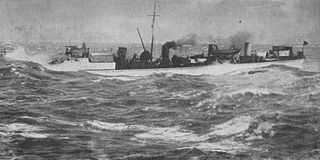
HMS Banshee was one of three Banshee-class destroyers which served with the Royal Navy.

The Sturgeon-class destroyers served with the Royal Navy from 1894; three were built by the Vickers yard and differed from other similar ships in having their mast stepped before the first funnel. They had Blechynden boilers which gave them 4,000 hp (3,000 kW) and 27 knots. They were armed with one twelve pounder and two torpedo tubes. They carried a complement of 53 officers and men.
HMS Skate was a Sturgeon-class destroyer which served with the Royal Navy. Built by Vickers, she was launched on 13 March 1895 and sold on 9 April 1907.

The Shikishima class was a two-ship class of pre-dreadnought battleships built for the Imperial Japanese Navy in the late 1890s. As Japan lacked the industrial capacity to build such warships herself, they were designed and built in the UK. The ships participated in the Russo-Japanese War of 1904–1905, including the Battle of Port Arthur on the second day of the war. Hatsuse sank after striking two mines off Port Arthur in May 1904. Shikishima fought in the Battles of the Yellow Sea and Tsushima and was lightly damaged in the latter action, although shells prematurely exploded in the barrels of her main guns in each battle. The ship was reclassified as a coast defence ship in 1921 and served as a training ship for the rest of her career. She was disarmed and hulked in 1923 and finally broken up for scrap in 1948.

ARA Garibaldi was one of four Giuseppe Garibaldi-class armored cruisers purchased by the Argentine Navy from Italy.
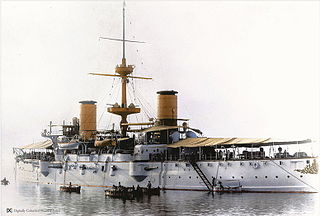
ARA Pueyrredón was one of four Giuseppe Garibaldi-class armored cruisers purchased by the Argentine Navy from Italy in the 1890s.

ARA San Martín was one of four Giuseppe Garibaldi-class armored cruisers purchased by the Argentine Navy from Italy.
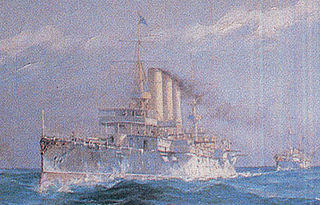
O'Higgins was a Chilean armoured cruiser. O'Higgins was built by the British shipbuilder Armstrong to the design of Philip Watts, and served with the Chilean Navy between 1898 and 1933.

HMS Venus was an Eclipse-class protected cruiser built for the Royal Navy in the mid-1890s.

HMS Dido was an Eclipse-class protected cruiser built for the Royal Navy in the mid-1890s.

Ministro Zenteno was a protected cruiser of the Chilean Navy.

ARA Libertad was a battleship that served in the Argentine Navy between 1892 and 1947, and with the Argentine Coast Guard as a pilot station ship from 1947 to 1968. It was the seventh Argentine naval ship with this name.
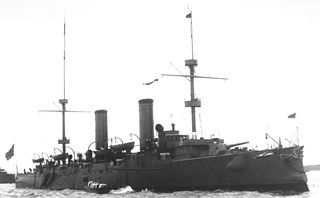
The Hai Chi class was a class of two protected cruisers built for the Qing Dynasty from 1896–1899. The Hai Chi class was ordered shortly after the conclusion of the First Sino-Japanese War from the United Kingdom to replace the catastrophic losses of the Beiyang Fleet. The Hai Chi class would remain one of the largest ship classes commissioned by China until the Cold War. The Hai Chi class would go on to serve in the Republic of China Navy through the National Protection War, World War I, the Second Zhili–Fengtian War, and the Northern Expedition.
